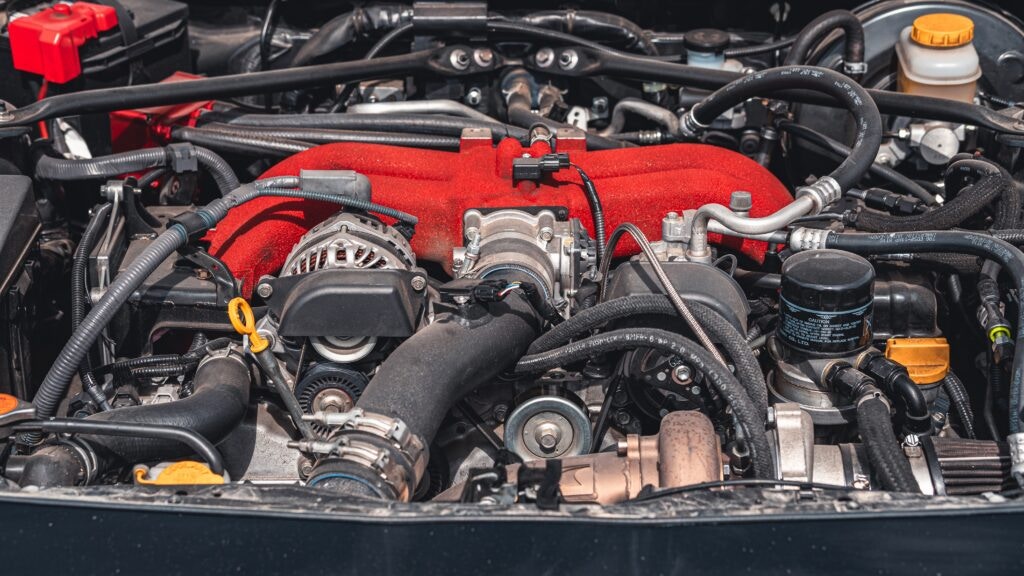How much does it cost to replace a cambelt?
Your car’s cambelt keeps the essential components of the engine working in sync. Any minor disturbance to your engine’s synchronicity can spell disaster for your vehicle, so proper cambelt maintenance is crucial for overall car performance and longevity.
But how do you know when your cambelt needs repair or replacement? In this guide, we walk you through factors affecting cambelt durability, signs you’re due for a replacement, and the various factors influencing cost (which typically sits between £300 to £600).
Whether you’re getting your car into shape for sale or performing routine maintenance, read on for all you need to know about cambelt replacement.
- What is a cambelt?
- Why is cambelt replacement necessary?
- Signs your cambelt needs to be replaced
- Replacement cost factors
- FAQs
What is a cambelt?

Also known as a timing belt, the cambelt synchronises the crankshaft and camshaft’s rotation in your engine. The camshaft lets fuel and air in and out of your engine, while the crankshaft moves the pistons.
Made of rubber and reinforced with fibres, cambelts ensure that the engine’s valves open and close at the right times during each cylinder’s intake and exhaust strokes. Disruption to this carefully calibrated system can cause serious engine damage.

Why is cambelt replacement necessary?
Given the high-pressure environment of your car’s engine, cambelts naturally deteriorate over time. Other factors contributing to cambelt failure include:
- High mileage
- Exposure to extreme temperatures
- Oil or coolant leaks
Neglecting cambelt replacement poses a significant risk of sudden and catastrophic engine failure, potentially leaving you stranded.
Signs your cambelt needs replacing

Unusual engine noises
Squealing, grinding, knocking, and other uncommon engine sounds can signal engine issues. These noises suggest cambelt wear, misalignment, or tension problems and call for prompt inspection to prevent engine damage.
Difficulty starting engine
Struggling to start the engine may point to a worn or damaged cambelt. A compromised belt affects engine timing, leading to delays in ignition.
Poor engine performance or misfiring
A worn cambelt disrupts the precise coordination of engine components, causing misfires and reduced performance. If your acceleration is sluggish or you’re experiencing a noticeable decrease in power, have your cambelt checked ASAP.
Replacement cost factors

Cambelt replacement should not be done at home; see a reputable mechanic or garage instead for this sensitive procedure.
The average cambelt replacement in the UK ranges from £300 to £800, including parts and labour. However, prices can vary based on a multitude of factors, so consulting with a mechanic is always a good place to start.
Car manufacturer and model
Different vehicles have varying engine designs, affecting how easy the cambelt replacement process is. Luxury or performance cars, for example, often have more intricate engine layouts and require additional time and expertise for repairs.
Additionally, manufacturers may recommend different cambelt replacement intervals depending on your car’s make and model.
See below for a table of estimated cambelt replacement costs for popular car brands in the UK:
| Car manufacturer | Popular models | Estimated cambelt replacement cost range (GBP) |
| Audi | Audi A3, Audi A4 | £400 to £800 |
| BMW | BMW 3 Series, BMW 5 Series | £400 to £800 |
| Ford | Ford Focus, Ford Fiesta | £300 to £500 |
| Mercedes-Benz | Mercedes-Benz C-Class | £500 to £800 |
| Toyota | Toyota Corolla, Yaris | £300 to £600 |
| Vauxhall | Vauxhall Astra, Corsa | £300 to £500 |
Replacement cambelt quality
Opting for an original equipment manufacturer (OEM) or a high-quality aftermarket cambelt for your replacement ensures reliability and reduces the risk of premature engine failure.
While budget options may seem initially appealing, investing in a reputable brand or OEM cambelt pays off in the long run as they are more likely to withstand engine conditions for longer.
Location and labour costs
Labour rates vary across regions; drivers in urban areas can expect to have higher mechanic fees than their rural counterparts.
Local market dynamics and parts availability can also influence cambelt replacement pricing.
Additional parts or services
Cambelt replacement costs may extend beyond just the belt. Some garage services include comprehensive packages with additional components, such as tensioners, pulleys, and water pumps.
The inclusion of these parts can contribute to a higher upfront cost, but often prove to be cost-effective in the long term in preventing the need for separate replacements and reducing the risk of related issues.

FAQs
Is replacing the water pump necessary during a cambelt replacement?
It’s advisable to replace the water pump during cambelt replacement. Neglecting it may lead to subsequent failures, as both components often wear out simultaneously.
What are the potential consequences of not replacing a worn-out cambelt?
Failing to replace a worn cambelt risks severe engine damage, which could require costly repairs and even merit a full engine replacement. Driving with a worn-out cambelt also threatens passenger safety.
Can I save money by replacing the cambelt myself?
Cambelt replacement requires precision; DIY attempts risk improper installation, which leads to engine damage. Professional service ensures reliability and prevents costly mistakes.
Are there any warranties or guarantees for cambelt replacements?
Many reputable garages offer warranties or guarantees on cambelt replacements, providing assurance against defects or premature failures. Research the garages in your area for more details.
How long do cambelts last?
Typically, cambelts last between 5 to 7 years, but mileage and usage patterns influence their lifespan. Regular inspections are crucial to determining when replacement is needed.
Is changing a cambelt a big job?
Cambelt replacement is a significant job that requires expertise. Using a mechanic or garage ensures proper installation, preventing potential engine damage and ensuring long-term reliability. Proper replacement can also help you get the best price when you choose to sell your car.
Need to sell your car?
Want to learn more about owning, maintaining, and selling your car? Check out more of our guides here, covering everything from Clean Air Zones to car tax, and plate changes to part exchange.
- Sell my car
- Track your car value
- What are the most expensive parts of a car to replace?
- Car anatomy: what are the parts of a car?
- How to remove car scratches?
- How much does it cost to replace a gearbox?
- How much does it cost to replace a car engine?
- How much does it cost to replace a car suspension?
- How much does it cost to replace brake pads?
- How much does it cost to replace a windscreen?
- How much does it cost to replace a head gasket?